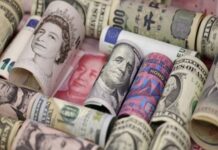SINGAPORE: The dollar was on track for its best week in over a month on Friday as investors wagered the Federal Reserve is unlikely to cut rates next month, with the case for further easing made no clearer by a confounding U.S. jobs report.
The yen briefly popped higher on Friday after Japanese Finance Minister Satsuki Katayama said intervention was a possibility in dealing with excessively volatile and speculative moves, in an escalation of jawboning from Tokyo to stem a sliding currency.
The release of the delayed U.S. nonfarm payrolls report on Thursday painted a mixed picture of the country’s labour market, showing employment growth accelerated in September, but the jobless rate rose to 4.4%, its highest level in four years.
That reinforced the view that the Fed is likely to hold off on cutting rates at its December meeting, as policymakers continue to sail through an economic fog brought about by the U.S. government shutdown.
Against the dollar, the euro was pinned near a two-week low and last bought $1.1528, on track for a weekly decline of 0.8%.
Sterling rose 0.11% to $1.3084, though was set to lose 0.7% for the week, with investors also anxiously awaiting Britain’s upcoming budget in a major test for the nation’s currency and bond markets.
The dollar index , which measures the greenback against a basket of peers, flirted with a 5-1/2-month peak and last stood at 100.20. It was on track to clock a weekly gain of 0.9%, its best performance in over a month.
“The shutdown-delayed September jobs report did not provide clarity on what the FOMC will do at its much-debated December meeting,” said economists at Wells Fargo in a note.
“We remain of the view that what the Fed should do is cut the federal funds rate by 25 bps… That said, what the Fed will do is a separate debate entirely,” said the economists, who added that their call for lowering rates in December was a “close” one and that a hold “would not surprise us at this point”.
Markets are now pricing in just a 27% chance of the Fed easing rates next month.
In other currencies, the Australian dollar was up 0.09% at $0.6446, after sliding 0.6% overnight on a broad risk-off mood in markets.
The New Zealand dollar rose 0.11% to $0.5588, having also lost 0.4% on Thursday.
Tumbling Yen Raises Intervention Threat
Much of the focus in the currency market this week has been on a sliding yen, which has plumbed fresh lows as investors fret about the nation’s worsening fiscal position brought about by Prime Minister Sanae Takaichi’s lavish stimulus package.
The cabinet plans to approve the package set to be worth some 21.3 trillion yen ($135.29 billion) later on Friday.
“At the very heart the problem is politicians making promises to electorates which defy economic reality,” said James Athey, a fixed income portfolio manager at Marlborough in London, referring to the steep selloff in Japanese bonds and the currency this week.
The yen languished near a 10-month low and was last at 157.33 per dollar, having bottomed at 157.90 in the previous session. It was set to lose nearly 2% for the week, its worst performance in over a month.
“The elephant in the room now is mounting intervention risks,” said Vishnu Varathan, head of macro research for Asia ex-Japan at Mizuho. “Interventions are likely to be opportunistic and short-lived. Essentially, speed bumps, not barricades.”
Tokyo last spent 5.53 trillion yen, or nearly $37 billion, in July 2024 intervening in the foreign exchange market to haul the yen away from 38-year lows.
Separately, data on Friday showed Japan’s core consumer prices rose 3.0% in October from a year earlier, staying above the central bank’s 2% target and keeping alive expectations of a near-term interest rate hike.























